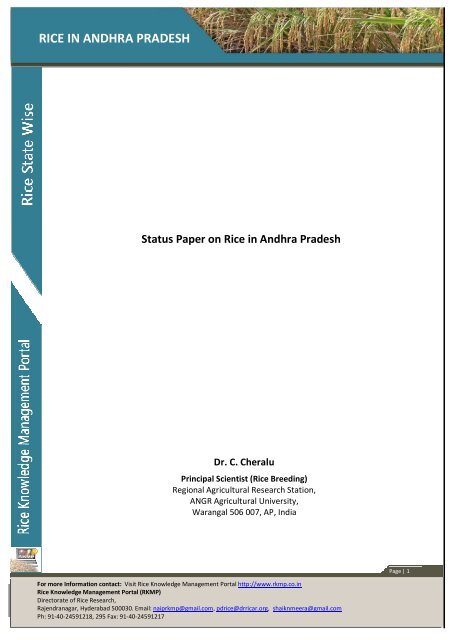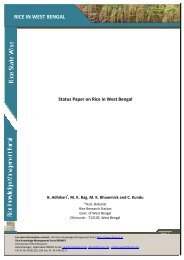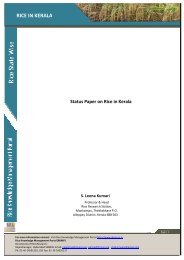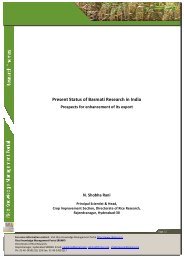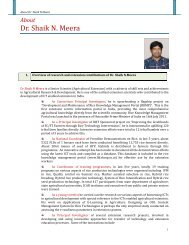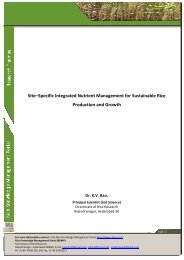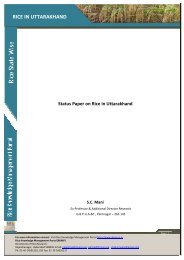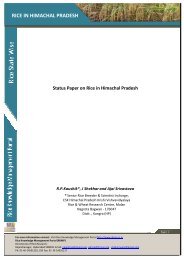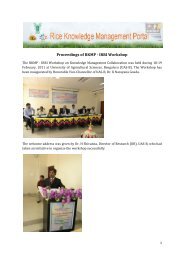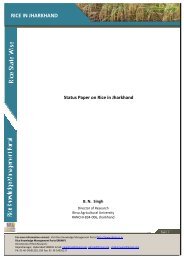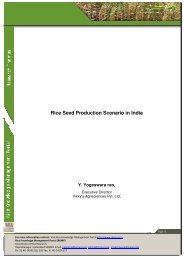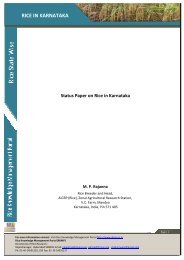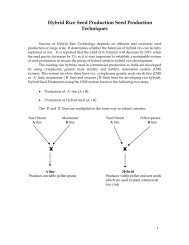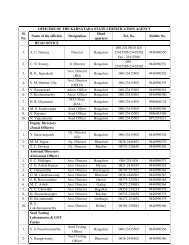RICE IN ANDHRA PRADESH - Rice Knowledge Management Portal
RICE IN ANDHRA PRADESH - Rice Knowledge Management Portal
RICE IN ANDHRA PRADESH - Rice Knowledge Management Portal
Create successful ePaper yourself
Turn your PDF publications into a flip-book with our unique Google optimized e-Paper software.
<strong>RICE</strong> <strong>IN</strong> <strong>ANDHRA</strong> <strong>PRADESH</strong><br />
Status Paper on <strong>Rice</strong> in Andhra Pradesh<br />
Dr. C. Cheralu<br />
Principal Scientist (<strong>Rice</strong> Breeding)<br />
Regional Agricultural Research Station,<br />
ANGR Agricultural University,<br />
Warangal 506 007, AP, India<br />
Page | 1<br />
For more Information contact: Visit <strong>Rice</strong> <strong>Knowledge</strong> <strong>Management</strong> <strong>Portal</strong> http://www.rkmp.co.in<br />
<strong>Rice</strong> <strong>Knowledge</strong> <strong>Management</strong> <strong>Portal</strong> (RKMP)<br />
Directorate of <strong>Rice</strong> Research,<br />
Rajendranagar, Hyderabad 500030. Email: naiprkmp@gmail.com, pdrice@drricar.org, shaiknmeera@gmail.com<br />
Ph: 91-40-24591218, 295 Fax: 91-40-24591217
<strong>RICE</strong> <strong>IN</strong> <strong>ANDHRA</strong> <strong>PRADESH</strong><br />
Introduction<br />
Andhra Pradesh is the fifth largest state in India accounting for 9 and 8 per cent of the country’s area<br />
and population, respectively. The state has agriculturally prosperous area in the coastal districts (9 districts),<br />
an economically and socially backward area in Telangana (10 districts), a drought prone area in Rayalaseema<br />
(4 districts) and a fairly extended tribal belt, along the Northern and North-Eastern regions. Andhra Pradesh<br />
has three major river basins (Krishna, Godavari and Pennar) and five other smaller ones drains in to the Bay<br />
of Bengal. The state has 972 km long coastal line, generally even, along its eastern border, abutting the Bay<br />
of Bengal.<br />
<strong>Rice</strong> is the Principal food crop cultivated throughout the state providing food for its growing<br />
population, fodder to the cattle and employment to the rural masses. Any decline in its hectarage and<br />
production will have a perceivable impact on the state’s economy and food security. In A.P rice is mostly<br />
cultivated under irrigated eco-system under canals (52%), tube wells (19.31) tanks (16.2%), other wells (8.8%)<br />
and other sources (3.7%).<br />
III.<br />
Zonal information<br />
a. Climate<br />
By virtue of its location and climate, Andhra Pradesh represents a transition from tropical to sub<br />
tropical zone of the country. The climate is predominantly semi arid to arid, except for the coastal region on<br />
the east coast which has humid to sub humid climate. Hot weather (summer) prevails from March to May,<br />
South West mansoon June to September, North east mansoon-October to December and winter December<br />
to February. Temperature ranges from 8 o C to 46 o C .<br />
b. Soil type/Nutrient management<br />
Andhra Pradesh is endowed with a wide variety of soils, ranging from less fertile coastal sands to<br />
highly fertile and productive deltaic alluvia (enti soils/verti sols) of the Godavari, Krishna and Pennar rivers<br />
and the red (alfisol) and black (verti sols) soils, developed from different parent materials. The six major soil<br />
groups present in the state are red soils (Alfi sols 65%), black soils (verti sols 25%), alluvial soils (Entisols and<br />
verti sols 5%) Coastal sands (Enti sols 3%), laterite and lataitic soils (Oxisols) and problem soils (Alfi sols &<br />
Incepti sols 1%) including saline, saline alkali and non saline-alkali soils.<br />
For more Information contact: Visit <strong>Rice</strong> <strong>Knowledge</strong> <strong>Management</strong> <strong>Portal</strong> http://www.rkmp.co.in<br />
<strong>Rice</strong> <strong>Knowledge</strong> <strong>Management</strong> <strong>Portal</strong> (RKMP)<br />
Directorate of <strong>Rice</strong> Research,<br />
Rajendranagar, Hyderabad 500030. Email: naiprkmp@gmail.com, pdrice@drricar.org, shaiknmeera@gmail.com<br />
Ph: 91-40-24591218, 295 Fax: 91-40-24591217<br />
Page | 2
<strong>RICE</strong> <strong>IN</strong> <strong>ANDHRA</strong> <strong>PRADESH</strong><br />
c. Rainfall and its distribution pattern<br />
Rainfall of Andhra Pradesh is influenced by both South West and North-East mansoons. The average<br />
rainfall of the state is 925 mm, varying from about 520 mm in Anantapur district to 1160 mm in Vizianagaram<br />
and East Godavari districts. In some years, Srikakulam, Vizianagaram, East Godavari, Adilabad and Khammam<br />
districts have recorded 1400 to 1500 mm rainfall.<br />
The distribution of annual rainfall in the state as a whole is about 69% during South West monsoon,<br />
22% during North-East mansoon and 9% during winter and hot weather months.<br />
d. Agro climatic zones<br />
Andhra Pradesh state has been divided into 9 Agro-climatic zones based on the amount and<br />
distribution of rainfall pattern.<br />
1. North Coastal Zone: Consists of most parts of Srikakulam, Vizianagaram, Visakhapatnam districts<br />
with regional Agricultural Research Station (RARS), Anakapalli as regional centre. This zone receives<br />
1000-1100mm rainfall and possesses 12.6% of rice area..<br />
2. Godavari Zone: Comprising East and West Godavari districts with regional Agricultural Research<br />
Station (RARS), Maruteru as regional centre. Annual rainfall varies from 800-1100 mm and has 46.5%<br />
of rice area of the state..<br />
3. Krishna Zone : Consists of Krishna, Guntur, Parts of Prakasham, Krammam and Nalgonda with Regional<br />
Agricultural Research Station, (RARS), Lam as regional centre. Important soil groups are deltaic<br />
Alluvium, red soils with clay base, black cotton soils, red loamy coastal sands and saline soils.<br />
4. Northern Telangana Zone: Comprising Adilabad, Nizamabad and Karimnagar with Regional Agricultural<br />
Research Station, (RARS), Jagtial as regional centre. Rain fall varies from 900-1150 mm and rice<br />
occupies 16% of rice area of the state.<br />
5. Central Telangana Zone: Consisting of Warangal, Medak and Khammam with Regional Agricultural<br />
Research Station (RARS), Warangal as regional centre.<br />
6. Southern Telangana Zone: Comprising the districts of Hyderabad Rangareddy, Mahboobnagar,<br />
Nalgonda with Regional Agricultural Research Station, (RARS) at Palem as regional centre. This zone<br />
receives 700-900 mm rain fall and has 9.3% of rice area of the state.<br />
For more Information contact: Visit <strong>Rice</strong> <strong>Knowledge</strong> <strong>Management</strong> <strong>Portal</strong> http://www.rkmp.co.in<br />
<strong>Rice</strong> <strong>Knowledge</strong> <strong>Management</strong> <strong>Portal</strong> (RKMP)<br />
Directorate of <strong>Rice</strong> Research,<br />
Rajendranagar, Hyderabad 500030. Email: naiprkmp@gmail.com, pdrice@drricar.org, shaiknmeera@gmail.com<br />
Ph: 91-40-24591218, 295 Fax: 91-40-24591217<br />
Page | 3
<strong>RICE</strong> <strong>IN</strong> <strong>ANDHRA</strong> <strong>PRADESH</strong><br />
7. Southern Zone: Includes the districts of Nellore, Chittoor Cadapah with Regional Agricultural Research<br />
(RARS), at Tirupathi as regional centre. Annual rainfall varies from<br />
700-1000 mm and has about 12.6% of rice area of the state.<br />
8. Scarce rainfall zone: Consisting of the districts of Kurnool, Anantapur, Prakasham parts of Cudapah<br />
and Mahboobnagar with Regional Agricultural Research Station (RARS) at Nandyal as Regional Centre<br />
. This zone has 3.8% of rice area. The average annual rainfall ranges from 500-700mm.<br />
9. High Altitude and Tribal area zone: Covering areas lying along the Srikakulam, Vizianagaram,<br />
Visakhapatnam, East Godavari and Khammam district with Regional Agricultural Research Station,<br />
Chintapalli as Regional centre. This zone receives high rainfall of over 1400 mm.<br />
e) <strong>Rice</strong> and cultural heritage in the state :<br />
<strong>Rice</strong> has a great cultural heritage . Many preparations viz., payasam,paravannam, ondrallu, arshalu,<br />
laddulu etc., are prepared and offered to the God at the time of worshipping. <strong>Rice</strong> is one among<br />
Navadhanyalu at the time of construction of houses (Bhoomipooja) and navagraha pooja.<strong>Rice</strong> is used<br />
as THALAMBRALU and AKSHANTHALU while mixing in turmeric powder and also used as<br />
VADIBIYYAM.<strong>Rice</strong> flakes (palalu) are used at the time of taking the deadbody to graveyard. Basumathi<br />
rice is a geographical indicator .<br />
IV.<br />
<strong>Rice</strong> production Scenario<br />
• Area: Area under rice mostly depends on the mansoon pattern and availability of water in reservoirs.<br />
Area under rice was high during 2008-09 (43.87 l.ha) and lowest is in 2002-03 (28.22 l.ha) Table-1.<br />
There is no scope for increasing area under rice and rice area is replaced by some profitable dry crops<br />
due to in sufficient water. <strong>Rice</strong> is grown in 28% of gross cropped area and 50% of area under food<br />
crops round the year in all the districts. Though there is a rise and fall of area and production of rice<br />
based on water availability, but there is a constant increase in productivity. In the context of food<br />
security such decline in area and production is not good to meet the future rice requirement. In the<br />
coastal districts the area under rice is declining because of aquaculture activities.<br />
• Production: <strong>Rice</strong> production depends up on the seasonal conditions prevailing during that particular<br />
year. Sofar highest production was realized (140.10 l.t) during 2008-09 and lowest (73.29 l.t) during<br />
2002-03. In the basal production, contribution of superfine varieties is 62% followed by 25% of fine<br />
For more Information contact: Visit <strong>Rice</strong> <strong>Knowledge</strong> <strong>Management</strong> <strong>Portal</strong> http://www.rkmp.co.in<br />
<strong>Rice</strong> <strong>Knowledge</strong> <strong>Management</strong> <strong>Portal</strong> (RKMP)<br />
Directorate of <strong>Rice</strong> Research,<br />
Rajendranagar, Hyderabad 500030. Email: naiprkmp@gmail.com, pdrice@drricar.org, shaiknmeera@gmail.com<br />
Ph: 91-40-24591218, 295 Fax: 91-40-24591217<br />
Page | 4
<strong>RICE</strong> <strong>IN</strong> <strong>ANDHRA</strong> <strong>PRADESH</strong><br />
varieties and the rest from common varieties. It is expected that about 20 lakh tones of fine rice<br />
would be exported from the state. More rice is produced in East Godavari (17.01 l.t), West Godavari<br />
(16.71 l.t), Krishna (11.42 l.t), Karimnagar (10.87 l.t), Guntur (10.27 l.t) and lowest in Ranga Reddy<br />
(1.04).<br />
• Productivity, Ecosystem wise : In A.P rice productivity is 3333 kg/ha compared to 2001 kg/ha (India)<br />
and 4112 kg/ha (world). <strong>Rice</strong> productivity is highest in Nellore district (4473kg/ha) followed by East<br />
Godavari (4028 kg/ha), West Godavari (3928 kg/ha) and lowest in Vishakhapatnam (2075 kg/ha). The<br />
crop is grown in three ecosystems viz., irrigated ecosystem (50.6%), rainfed low land (43.8%) and<br />
rainfed uplands (5.6%) . In A.P realized yields are above state average in 9 districts i.e., Nellore (4473<br />
kg/ha), East Godavari (4028 kg/ha), West Godavari (3928 kg/ha), Prakasham (3779 kg/ha),<br />
Nizamabad (3629 kg/ha), Nalgonda (3555 kg/ha), Adilabad (3878 kg/ha), Guntur (3468 kg/ha),<br />
Khammam (3376 kg/ha) and in 13 districts yields are less than the state average and lowest in<br />
Vishakhapatnam district (2075 kg/ha).<br />
• Yield gap and its reasons: Most of the varieties already released and recommended are capable of<br />
yielding 4.0 to 5.0 t/ha of rice under field conditions against the average yield of 3.43 t/ha being<br />
achieved by the state. Thus, there still exists an yield gap of 0.5 to 1.5 t/ha even with the available<br />
varieties and technologies.<br />
To achieve the yield potential already created, farmers have to necessarily adopt recommended<br />
package in totality. Farmers are adopting the improved variety and a part of the package not giving adequate<br />
attention to the remaining component particularly the correction of soil problems, nutritional disorders and<br />
water management to some extent. Over 5000 litres of water is required to produce 1 kilogram of rice. Most<br />
if it is used for soil preparation and weed suppression. To make rice farming more profitable, water use<br />
efficiency has to be improved a lot in addition to other factors.<br />
Though the yields are increasing over the years to varying degree they are not proportionate to the<br />
increase in production cost. The factor productivity which is on decline should improve. Therefore, the<br />
research and extension efforts will have to focus on the efficient use of inputs, reduction in the costs of<br />
production, minimizing input losses and maximize output through scientific crop production and protection<br />
technologies like Maintance of optimum population, water, soil test based integrated nutrient management,<br />
integrated pest management, in addition to sustainable soil management, harvest and post harvest<br />
management.<br />
For more Information contact: Visit <strong>Rice</strong> <strong>Knowledge</strong> <strong>Management</strong> <strong>Portal</strong> http://www.rkmp.co.in<br />
<strong>Rice</strong> <strong>Knowledge</strong> <strong>Management</strong> <strong>Portal</strong> (RKMP)<br />
Directorate of <strong>Rice</strong> Research,<br />
Rajendranagar, Hyderabad 500030. Email: naiprkmp@gmail.com, pdrice@drricar.org, shaiknmeera@gmail.com<br />
Ph: 91-40-24591218, 295 Fax: 91-40-24591217<br />
Page | 5
<strong>RICE</strong> <strong>IN</strong> <strong>ANDHRA</strong> <strong>PRADESH</strong><br />
The state being one of the highest fertilizer and pesticides consuming regions in the country, the key<br />
factor leading to the difference in rice yields between A.P on one side and Punjab and Tamilnadu on the<br />
other is the proportionate share of groundwater irrigated area which is 62% in Punjab, 45% in Tamilnadu<br />
compared to 35% in A.P while Punjab and Tamilnadu developed 99% and 60% of their ultimate ground water<br />
potential respectively. A.P developed less than 20% of its ground water potential. Ground water<br />
development, thus, appears crucial for stepping up rice yields.<br />
Another crucial factor in this regard is the extent of irrigated rice area in Andhra Pradesh. Although<br />
rice is said to be irrigated to an extent of 95% of the area planted in the state, 50% is under tanks, wells and<br />
tube wells which in turn depend on the rainfall and good mansoon. How dependable is this source is known<br />
to every one. Thus, only 50% of the rice area gets assured irrigation water through canals under major<br />
projects.<br />
A third and major factor which is pulling down the rice yields in the state is damage due to frequent<br />
cyclones and floods which are common at the time of harvest. Biotic and abiotic stresses are the other<br />
factors greatly influencing the yield gaps apart from others.<br />
e. Major contributing factors in different ecologies:<br />
Under Irrigated transplanted ecology assured water, intensive cultivation with high inputs using high<br />
yielding varieties and adoption of plant protection measures -are the major contributing factors for higher<br />
productivity. Cyclones, floods , weeds , sub-mergens of the crop at critical stages and rodents are the yield<br />
reducers.<br />
In Rainfed lowland ecology high rain fall, fertile soils, availability of suitable varieties, high input use,<br />
scope for giving irrigation at critical (later stages i. e., from tillering onwards) stages ,need based plant<br />
protection are the factors for higher yields. Drought, planting of overaged seedlings, intermittent dryspells<br />
during crop growth period and inadequate fertilizer application and Plant protection measures are the<br />
reasons for low yields.<br />
In rainfed ecology, uncertainity of rainfall, intermittent dry spells, weeds and lack of suitable high<br />
yielding varieties with production technology are the reasons for low yields.<br />
f) Contribution to the GDP: Andhra Pradesh contributes 16-18% towards rice production from an area<br />
of about 10% of country’s rice area.<br />
For more Information contact: Visit <strong>Rice</strong> <strong>Knowledge</strong> <strong>Management</strong> <strong>Portal</strong> http://www.rkmp.co.in<br />
<strong>Rice</strong> <strong>Knowledge</strong> <strong>Management</strong> <strong>Portal</strong> (RKMP)<br />
Directorate of <strong>Rice</strong> Research,<br />
Rajendranagar, Hyderabad 500030. Email: naiprkmp@gmail.com, pdrice@drricar.org, shaiknmeera@gmail.com<br />
Ph: 91-40-24591218, 295 Fax: 91-40-24591217<br />
Page | 6
<strong>RICE</strong> <strong>IN</strong> <strong>ANDHRA</strong> <strong>PRADESH</strong><br />
V. Region wise/District wise rice Ecosystems<br />
In Telangana region:<br />
Coastal Andhra Pradesh:<br />
Rayala Seema :<br />
Irrigated ecosystem<br />
Rainfed low land eco system<br />
Irrigated eco system<br />
Submergence conditions<br />
Rainfed lowland eco system<br />
Irrigated ecosystem<br />
Irrigated ecosystem: <strong>Rice</strong> crop is mostly grown under different sources of irrigation under puddle conditions<br />
by growing dry or wet nurseries. Field is prepared with desi plough drawn by he buffaloes or by tractors.<br />
Transplantation is mostly done by contract labour by random planting method called “Chikku natu” where<br />
plant population is low.<br />
Rainfed low land eco system: In Kothaguda, Mulugu agency area of Warangal district, Bhadrachalam area of<br />
Khammam district and also is some parts ofr North Coastal area, dry nursery is raised with the on set of<br />
mansoon. The field is bunded so that the rain water from upper area gets accumulated in the field and crop<br />
resembles as if it is grown as a translplanted crop. Sometimes after dry sowing, the field is converted to wet<br />
cultivation as and when water is available. This practice is common in Visakhapatnam and Sri Kakulam<br />
district.<br />
Rainfed eco system:In some North Coastal districts and Telangana area rice is cultivated as a rainfed crop.<br />
Varieties grown under this condition are Akasavari, MTU-9992, MTU-17, mettasannalu, Varalu and all these<br />
varieties have drought resistance. They are sown behind the plough or seed drill. Some times redgram or<br />
hibiscus is taken as an intercrop. Rainfed rice varieties face intermittent drought spells. They have very good<br />
ability to recover from drought in seedling stage and maximum losses occur, if the drought prevails at<br />
flowering stage.<br />
VI.<br />
VII.<br />
<strong>Rice</strong> production and economic analysis<br />
<strong>Rice</strong> and rice based cropping systems – zone wise<br />
Godavari Zone :<br />
<strong>Rice</strong>-<strong>Rice</strong>-Pulses<br />
<strong>Rice</strong>-<strong>Rice</strong><br />
<strong>Rice</strong>-Green manures<br />
Page | 7<br />
For more Information contact: Visit <strong>Rice</strong> <strong>Knowledge</strong> <strong>Management</strong> <strong>Portal</strong> http://www.rkmp.co.in<br />
<strong>Rice</strong> <strong>Knowledge</strong> <strong>Management</strong> <strong>Portal</strong> (RKMP)<br />
Directorate of <strong>Rice</strong> Research,<br />
Rajendranagar, Hyderabad 500030. Email: naiprkmp@gmail.com, pdrice@drricar.org, shaiknmeera@gmail.com<br />
Ph: 91-40-24591218, 295 Fax: 91-40-24591217
<strong>RICE</strong> <strong>IN</strong> <strong>ANDHRA</strong> <strong>PRADESH</strong><br />
<strong>Rice</strong>-Vegetables<br />
<strong>Rice</strong>-Maize<br />
<strong>Rice</strong>-<strong>Rice</strong>-Green manure/<strong>Rice</strong>-Green manures<br />
Krishna Zone:<br />
North Coastal zone:<br />
Northern Telangana Zone :<br />
Central Telangana Zone:<br />
Southern Telangana Zone:<br />
South Zone:<br />
Scarce rainfall Zon:<br />
<strong>Rice</strong>-<strong>Rice</strong><br />
<strong>Rice</strong>-Pulses (Greengram/blackgram)<br />
<strong>Rice</strong>-Zero tillage, Maize<br />
<strong>Rice</strong>-Vegetables<br />
<strong>Rice</strong>-<strong>Rice</strong>-Green manure<br />
<strong>Rice</strong>- <strong>Rice</strong><br />
<strong>Rice</strong>- Pulses<br />
<strong>Rice</strong>- Sugarcane<br />
<strong>Rice</strong>- Millets<br />
<strong>Rice</strong>- Green manures<br />
<strong>Rice</strong>- <strong>Rice</strong> - rice<br />
<strong>Rice</strong>- <strong>Rice</strong><br />
<strong>Rice</strong>- Sunflower/Maze<br />
<strong>Rice</strong>- Fodders<br />
<strong>Rice</strong>- Greenmanures<br />
<strong>Rice</strong>- <strong>Rice</strong>- <strong>Rice</strong><br />
<strong>Rice</strong>- <strong>Rice</strong><br />
<strong>Rice</strong>- Greenmanures<br />
<strong>Rice</strong>- Maize<br />
<strong>Rice</strong>- <strong>Rice</strong>- <strong>Rice</strong><br />
<strong>Rice</strong>- <strong>Rice</strong><br />
<strong>Rice</strong>- Vegetables<br />
<strong>Rice</strong>- Greenmanures<br />
<strong>Rice</strong>- <strong>Rice</strong>- <strong>Rice</strong><br />
<strong>Rice</strong>- Groundnut<br />
<strong>Rice</strong>- <strong>Rice</strong><br />
<strong>Rice</strong>- <strong>Rice</strong><br />
<strong>Rice</strong>- Groundnut<br />
Page | 8<br />
For more Information contact: Visit <strong>Rice</strong> <strong>Knowledge</strong> <strong>Management</strong> <strong>Portal</strong> http://www.rkmp.co.in<br />
<strong>Rice</strong> <strong>Knowledge</strong> <strong>Management</strong> <strong>Portal</strong> (RKMP)<br />
Directorate of <strong>Rice</strong> Research,<br />
Rajendranagar, Hyderabad 500030. Email: naiprkmp@gmail.com, pdrice@drricar.org, shaiknmeera@gmail.com<br />
Ph: 91-40-24591218, 295 Fax: 91-40-24591217
<strong>RICE</strong> <strong>IN</strong> <strong>ANDHRA</strong> <strong>PRADESH</strong><br />
<strong>Rice</strong>- Sunflower<br />
<strong>Rice</strong>- Greenmanure<br />
High Altitude and Tribal Zone: <strong>Rice</strong>- <strong>Rice</strong><br />
<strong>Rice</strong>- Oilseeds<br />
<strong>Rice</strong>- Pulses<br />
VIII <strong>Rice</strong> growing seasons of different regions<br />
Region First crop Second crop Third crop<br />
Coastal<br />
Andhra<br />
Saarva (Kharif)<br />
Dalva (Rabi season)<br />
-<br />
Pradesh<br />
June - November<br />
November - March)<br />
Telangana<br />
Aabi (Kharif season)<br />
Taabi (Rabi season)<br />
Kathera (Summer)<br />
June – November<br />
15 th November –April<br />
April – July<br />
Rayalasema<br />
Vanakaru (Kharif)<br />
Endakaru (Rabi)<br />
Mokkadugu(Summar)<br />
June – December<br />
November - March<br />
February- May<br />
Edagaru(Early Kharif<br />
May – August<br />
Page | 9<br />
For more Information contact: Visit <strong>Rice</strong> <strong>Knowledge</strong> <strong>Management</strong> <strong>Portal</strong> http://www.rkmp.co.in<br />
<strong>Rice</strong> <strong>Knowledge</strong> <strong>Management</strong> <strong>Portal</strong> (RKMP)<br />
Directorate of <strong>Rice</strong> Research,<br />
Rajendranagar, Hyderabad 500030. Email: naiprkmp@gmail.com, pdrice@drricar.org, shaiknmeera@gmail.com<br />
Ph: 91-40-24591218, 295 Fax: 91-40-24591217
<strong>RICE</strong> <strong>IN</strong> <strong>ANDHRA</strong> <strong>PRADESH</strong><br />
IX.<br />
Recommended package of practices<br />
a) Varieties/hybrids : Recommended varieties or hybrids for different situations<br />
Seasons<br />
High<br />
Scarce<br />
South<br />
Central<br />
Northern<br />
South<br />
North<br />
Godavari<br />
Krishna<br />
/<br />
altitude<br />
rainfall<br />
Telangana<br />
Telangana<br />
Telangana<br />
zone<br />
Coastal<br />
zone<br />
Zone<br />
Situations<br />
and tribal<br />
zone<br />
Zone<br />
zone<br />
Zone<br />
Zone<br />
zone<br />
1 2 3 4 5 6 7 8 9 10<br />
Early<br />
- - Pushpala,<br />
Bharani,<br />
Swarna,<br />
Swarn<br />
- Pushkal<br />
Kharif<br />
Cottondora<br />
Nidhi,<br />
Samba<br />
a,<br />
-<br />
a,<br />
Sannalu,<br />
Shravani,<br />
Somasila<br />
mahsuri,<br />
Phalguna<br />
Samba<br />
mahsu<br />
ri,<br />
rabi<br />
IR.64<br />
Phalgu<br />
na<br />
Vijeth<br />
a<br />
Normal<br />
Swarna,<br />
Swarna,<br />
Srikakulam<br />
Penna,<br />
Bhadrakali<br />
Bhadr<br />
Samba<br />
Samba<br />
Srikakul<br />
planting<br />
Chaitanya,<br />
Krishna<br />
veni,<br />
Deepthi,<br />
Prathibha,<br />
Surya,<br />
Bapatla<br />
Chaitan<br />
ya,<br />
Krishna<br />
ve<br />
Ni,<br />
Prathib<br />
a,<br />
Sannalu,<br />
Swarna,<br />
Chaitanya,<br />
Vasundhara<br />
Sonamah<br />
suri<br />
Simhapuri<br />
,<br />
Tikkana,<br />
Pinakini<br />
Savithri,<br />
Sriranga,<br />
Vedagiri,<br />
Kavya,<br />
Shiva,<br />
Warangal<br />
Samba,<br />
Warangal<br />
Sannalu<br />
a<br />
kali<br />
Kavya,<br />
Shiva,<br />
Waran<br />
gal<br />
Samba<br />
Mahsuri,<br />
Sagarsa<br />
mba,<br />
Earlysam<br />
ba<br />
Rajavadl<br />
u,<br />
mahsuri<br />
Sonamah<br />
suri,<br />
Depthi,<br />
Nandyala<br />
sannalu<br />
am<br />
sannalu,<br />
Phalghu<br />
na,<br />
Suraksh<br />
a,<br />
Vijetha,<br />
Vasund<br />
Page | 10<br />
For more Information contact: Visit <strong>Rice</strong> <strong>Knowledge</strong> <strong>Management</strong> <strong>Portal</strong> http://www.rkmp.co.in<br />
<strong>Rice</strong> <strong>Knowledge</strong> <strong>Management</strong> <strong>Portal</strong> (RKMP)<br />
Directorate of <strong>Rice</strong> Research,<br />
Rajendranagar, Hyderabad 500030. Email: naiprkmp@gmail.com, pdrice@drricar.org, shaiknmeera@gmail.com<br />
Ph: 91-40-24591218, 295 Fax: 91-40-24591217
<strong>RICE</strong> <strong>IN</strong> <strong>ANDHRA</strong> <strong>PRADESH</strong><br />
sannalu,<br />
Surya,<br />
Srikurma,<br />
Pardhiva,<br />
Keshava,<br />
,<br />
Chandan,<br />
hara<br />
Indhra,<br />
Tolakari<br />
Vijetha.<br />
NLR 9674<br />
Ramappa,<br />
Waran<br />
Kavya,<br />
for<br />
Prakasham<br />
,<br />
Amara<br />
Polasa<br />
Prabha,<br />
gal<br />
sannal<br />
u<br />
Salema,<br />
Satya,<br />
District;<br />
Jagityala<br />
Kesha<br />
Erramall<br />
Sriranga,<br />
Sannalu,<br />
va,<br />
elu,<br />
NLR-9674,<br />
Jagityala<br />
Ramap<br />
Tellaham<br />
Pardiva,<br />
Samba,<br />
pa<br />
sa,<br />
Swarna<br />
mukhi<br />
Manerson<br />
a<br />
Indursamb<br />
Polasa<br />
prabh<br />
a,<br />
Sumathi,<br />
Taramat<br />
hi,<br />
a<br />
Vijetha,<br />
cotton<br />
Jagitya<br />
la<br />
Sannal<br />
u,<br />
Suganda<br />
mathi<br />
Dorasanna<br />
lu<br />
Jagitya<br />
la<br />
Palalavadl<br />
u,<br />
Samba<br />
,<br />
Maner<br />
sona<br />
Indur<br />
samba<br />
Vijeth<br />
a,<br />
Page | 11<br />
For more Information contact: Visit <strong>Rice</strong> <strong>Knowledge</strong> <strong>Management</strong> <strong>Portal</strong> http://www.rkmp.co.in<br />
<strong>Rice</strong> <strong>Knowledge</strong> <strong>Management</strong> <strong>Portal</strong> (RKMP)<br />
Directorate of <strong>Rice</strong> Research,<br />
Rajendranagar, Hyderabad 500030. Email: naiprkmp@gmail.com, pdrice@drricar.org, shaiknmeera@gmail.com<br />
Ph: 91-40-24591218, 295 Fax: 91-40-24591217
<strong>RICE</strong> <strong>IN</strong> <strong>ANDHRA</strong> <strong>PRADESH</strong><br />
cotton<br />
Dora<br />
sannal<br />
u<br />
Over<br />
Swarna,<br />
Swarna,<br />
Srikakulam<br />
Simhapuri<br />
Swarna,<br />
Swarn<br />
Swarna,<br />
Samba<br />
Sonama<br />
aged<br />
seedling<br />
planting<br />
Indhra,<br />
Bapatla<br />
sannalu,<br />
Amara<br />
Chaitan<br />
ya,Indh<br />
ra,<br />
Amara<br />
sannalu,<br />
Swarna<br />
,Tikkana,<br />
Sri Ranga,<br />
Swarna<br />
Mukhi,<br />
Warangal<br />
Samba,<br />
Warangal<br />
Sannalu<br />
a,<br />
Waran<br />
gal<br />
Sannal<br />
u,<br />
Phalguna<br />
Surekha,<br />
Kavya,<br />
Samba<br />
Mhsuri,<br />
Sona<br />
mahsuri<br />
hsuri<br />
Pardhiva,<br />
Samba<br />
mahsuri<br />
Waran<br />
gal<br />
samba<br />
mahsuri<br />
Polasa<br />
prabha<br />
Samba<br />
mahsu<br />
ri<br />
polasa<br />
prabh<br />
a<br />
BPH<br />
Chaitanya,<br />
Chaitan<br />
Chaitanya,<br />
Deepthi,<br />
Vijetha<br />
Vijeth<br />
Vijetha,<br />
Deepthi<br />
Deepthi<br />
Prone<br />
areas<br />
Krishnaven<br />
i,Deepthi,<br />
Indhra and<br />
ya,Krish<br />
na<br />
veni,<br />
Deepthi,<br />
Vijetha<br />
Vijetha,<br />
cotton<br />
dora<br />
sannalu<br />
a<br />
cotton<br />
dora<br />
sannal<br />
cotton<br />
dora<br />
sannalu<br />
, Vijetha<br />
Amara.<br />
Deepthi<br />
,<br />
u<br />
Indhra<br />
Godava<br />
Page | 12<br />
For more Information contact: Visit <strong>Rice</strong> <strong>Knowledge</strong> <strong>Management</strong> <strong>Portal</strong> http://www.rkmp.co.in<br />
<strong>Rice</strong> <strong>Knowledge</strong> <strong>Management</strong> <strong>Portal</strong> (RKMP)<br />
Directorate of <strong>Rice</strong> Research,<br />
Rajendranagar, Hyderabad 500030. Email: naiprkmp@gmail.com, pdrice@drricar.org, shaiknmeera@gmail.com<br />
Ph: 91-40-24591218, 295 Fax: 91-40-24591217
<strong>RICE</strong> <strong>IN</strong> <strong>ANDHRA</strong> <strong>PRADESH</strong><br />
ri,<br />
Indhra<br />
Submer<br />
Bapatla<br />
Badava<br />
Srikakulam<br />
Badava<br />
_ _ _ _ Swarna<br />
gence<br />
sannalu,<br />
Mahsur<br />
sannalu,<br />
Mahsuri<br />
areas<br />
Swarna,<br />
i,<br />
Badava<br />
Savithri<br />
Krishnaven<br />
Indhra,<br />
mahsuri<br />
i Indhra<br />
Swarna<br />
Seasons/<br />
High<br />
Scarce<br />
South<br />
Central<br />
Northern<br />
South<br />
North<br />
Godavari<br />
Krishna<br />
Situa-<br />
altitude<br />
rainfall<br />
Telangana<br />
Telangana<br />
Telangana<br />
zone<br />
Coastal<br />
zone<br />
Zone<br />
tions<br />
and tribal<br />
Zone<br />
zone<br />
Zone<br />
Zone<br />
zone<br />
zone<br />
1 2 3 4 5 6 7 8 9 10<br />
Saline<br />
Deepthi,<br />
Deepthi<br />
Deepthi,<br />
Vedagiri,<br />
Vikas Vikas Vikas - -<br />
soils<br />
Vikas,<br />
Vikas,<br />
Swarna<br />
Vedagiri,<br />
Somashila<br />
mukhi,<br />
Somashila<br />
Somashila<br />
Late<br />
Swarna,<br />
Swarna,<br />
Vasundhara<br />
Swarna<br />
Keshava,<br />
Erramall<br />
Surekha,<br />
Samba<br />
-<br />
plantings<br />
Chaitanya,<br />
Chaitan<br />
Suraksha,<br />
Mukhi,<br />
Pothana,<br />
elu<br />
Kavya,<br />
mahsuri,<br />
Vijetha,<br />
Cottondora<br />
ya<br />
Vijetha,<br />
Vamshi,<br />
cotton<br />
Swathi,<br />
Shravani,<br />
Indur<br />
samba,<br />
Pothana<br />
Ramapp<br />
a jagtial<br />
Erramall<br />
eluSatya,<br />
Sona<br />
mahsuri,<br />
sannalu<br />
Cotton<br />
Dora<br />
Sathya,<br />
Erramallel<br />
sannalu<br />
keshava<br />
Tellaham<br />
saKrishn<br />
Nandyala<br />
Page | 13<br />
For more Information contact: Visit <strong>Rice</strong> <strong>Knowledge</strong> <strong>Management</strong> <strong>Portal</strong> http://www.rkmp.co.in<br />
<strong>Rice</strong> <strong>Knowledge</strong> <strong>Management</strong> <strong>Portal</strong> (RKMP)<br />
Directorate of <strong>Rice</strong> Research,<br />
Rajendranagar, Hyderabad 500030. Email: naiprkmp@gmail.com, pdrice@drricar.org, shaiknmeera@gmail.com<br />
Ph: 91-40-24591218, 295 Fax: 91-40-24591217
<strong>RICE</strong> <strong>IN</strong> <strong>ANDHRA</strong> <strong>PRADESH</strong><br />
Dora<br />
sannalu Apurva u<br />
JGL-<br />
a Hamsa,<br />
sannalu,<br />
sannalu<br />
Ramappa<br />
Jagtial<br />
3844<br />
Indursa<br />
mba<br />
Rajavadl<br />
u<br />
Sathya,<br />
Swathi,<br />
sannalu-<br />
3844<br />
Somashil<br />
aShravan<br />
i<br />
Rainfed<br />
MTU-9993,<br />
MTU-<br />
Pushkala,<br />
- MTU-<br />
- - - MTU-<br />
situation<br />
Maruteru<br />
sannalu<br />
Varalu<br />
9993<br />
Maruter<br />
u<br />
sannalu,<br />
MTU-9993,<br />
Maruteru<br />
Sannalu<br />
9993,<br />
Rudrama,<br />
Varalu<br />
9993,<br />
Maruteru<br />
sannalu<br />
Varalu<br />
Varalu,<br />
Pushkala,<br />
Srisatya<br />
Srisatya<br />
Irrigated<br />
Swarna,<br />
Swarna,<br />
Swarna,<br />
Thikkana,<br />
Varalu Varalu Swathi,<br />
- -<br />
MTU-9993,<br />
Maruterru<br />
dry<br />
conditions<br />
MTU-<br />
9993,<br />
Sona<br />
mahsuri,<br />
Swarna<br />
mukhi,<br />
Nandyala<br />
sannalu<br />
sannalu,<br />
Swarna<br />
mukhi,<br />
Cotton<br />
Maruter<br />
u<br />
sannalu,<br />
Cotton<br />
Cotton<br />
Dora<br />
sannalu,<br />
Vijetha<br />
Vijetha<br />
Dora<br />
Dora<br />
Sannalu,<br />
Sannalu,<br />
Vijetha<br />
Vijetha.<br />
Page | 14<br />
For more Information contact: Visit <strong>Rice</strong> <strong>Knowledge</strong> <strong>Management</strong> <strong>Portal</strong> http://www.rkmp.co.in<br />
<strong>Rice</strong> <strong>Knowledge</strong> <strong>Management</strong> <strong>Portal</strong> (RKMP)<br />
Directorate of <strong>Rice</strong> Research,<br />
Rajendranagar, Hyderabad 500030. Email: naiprkmp@gmail.com, pdrice@drricar.org, shaiknmeera@gmail.com<br />
Ph: 91-40-24591218, 295 Fax: 91-40-24591217
<strong>RICE</strong> <strong>IN</strong> <strong>ANDHRA</strong> <strong>PRADESH</strong><br />
SUITABLE VARIETIES FOR RABI SEASON<br />
Normal<br />
Cotton<br />
Cotton<br />
Pushkala ,<br />
Swarna<br />
Erramallel<br />
Erramall<br />
Keshava,<br />
Swathi,<br />
Pushkala,<br />
sowings<br />
Dora<br />
sannalu,<br />
Vijetha,<br />
Dora<br />
sannalu,<br />
Vijetha,<br />
Cotton<br />
Dora<br />
sannalu,<br />
Vijetha<br />
mukhi,<br />
Swathi,<br />
Vijetha,<br />
u,Indursa<br />
mba,<br />
Warangal<br />
Sannalu,<br />
elu,War<br />
angal<br />
samba,<br />
Warang<br />
Tellaham<br />
saSatya,<br />
Taramati<br />
,<br />
sathya,<br />
Rasi,<br />
Nandyala<br />
Cotton<br />
Dora<br />
sannalu,<br />
IR. 64,<br />
Jagityala<br />
Prabhat<br />
h,<br />
Apurva,<br />
Cotton<br />
Warangal<br />
samba<br />
al<br />
sannalu,<br />
Erramall<br />
elu<br />
sanallu,<br />
Cotton<br />
Vijetha<br />
Sannalu,<br />
IR. 64,<br />
Dora<br />
Indur<br />
Dora<br />
Nelluru<br />
Jagityal<br />
sannalu,<br />
samba,<br />
sannalu,<br />
mahsuri<br />
sannalu,<br />
Nelluri<br />
Jagityala<br />
sannalu,<br />
Manair<br />
samba,<br />
Nelluru<br />
mahsuri<br />
mahsuri<br />
Nelluru<br />
manair<br />
sannalu<br />
mahsuri<br />
Late<br />
Cotton<br />
Cotton<br />
Pushkala,<br />
Swathi,<br />
Tellahams<br />
Tellaha<br />
Erramall<br />
Swathi,<br />
Pushkala,<br />
sowings<br />
Dora<br />
sannalu<br />
Dora<br />
sannalu<br />
Cotton Dora<br />
sannalu<br />
Shrawani,<br />
Sathya,<br />
Somashila<br />
,Vijetha,<br />
cotton<br />
Dora<br />
sannalu<br />
a,<br />
Sathya,<br />
Rasi,<br />
Keshava,<br />
Varsha,<br />
Pothana,<br />
IR. 64<br />
msa,<br />
Rasi,<br />
Keshava<br />
,<br />
Varsha,<br />
Sathya,<br />
Potana,<br />
I.R. 64<br />
eluPrasa<br />
nna<br />
Rasi,<br />
Pothana,<br />
I.R. 64,<br />
Krishna<br />
hamsa<br />
Shravani<br />
Sathya,<br />
Rasi<br />
IR.64,<br />
Abhaya,<br />
Rasi<br />
Page | 15<br />
For more Information contact: Visit <strong>Rice</strong> <strong>Knowledge</strong> <strong>Management</strong> <strong>Portal</strong> http://www.rkmp.co.in<br />
<strong>Rice</strong> <strong>Knowledge</strong> <strong>Management</strong> <strong>Portal</strong> (RKMP)<br />
Directorate of <strong>Rice</strong> Research,<br />
Rajendranagar, Hyderabad 500030. Email: naiprkmp@gmail.com, pdrice@drricar.org, shaiknmeera@gmail.com<br />
Ph: 91-40-24591218, 295 Fax: 91-40-24591217
<strong>RICE</strong> <strong>IN</strong> <strong>ANDHRA</strong> <strong>PRADESH</strong><br />
BPH<br />
Vijetha,<br />
Vijetha,<br />
Vijetha,<br />
Deepthi,<br />
Cotton<br />
Cotton<br />
Cotton<br />
- Cotton<br />
Prone<br />
Cotton<br />
Cotton<br />
Cotton<br />
Vijetha,<br />
Dora<br />
Dora<br />
Dora<br />
Dora<br />
areas<br />
Dora<br />
Dora<br />
Dora<br />
Cotton<br />
sannalu<br />
sannalu<br />
sannalu<br />
sannalu<br />
sannalu<br />
sannalu<br />
sannalu<br />
Dora<br />
sannalu<br />
Seasons/<br />
High<br />
Scarce<br />
South<br />
Central<br />
Northern<br />
South<br />
North<br />
Godavari<br />
Krishna<br />
Situa-<br />
altitude<br />
rainfall<br />
Telangana<br />
Telangana<br />
Telangana<br />
zone<br />
Coastal<br />
zone<br />
Zone<br />
tions<br />
and tribal<br />
Zone<br />
zone<br />
Zone<br />
Zone<br />
zone<br />
zone<br />
1 2 3 4 5 6 7 8 9 10<br />
Salt<br />
Somashila - Somashila Somashila Vikas Vikas Vikas - -<br />
Prone<br />
areas<br />
HYBRIDS<br />
APHR-1,<br />
APHR-1,<br />
APHR-1,<br />
Somashila Vikas Vikas Vikas - -<br />
APHR-2,<br />
APHR-2,<br />
APHR-2,<br />
KRH-2,<br />
KRH-2,<br />
KRH-2, PHB-<br />
PHB-71,<br />
PHB-71,<br />
71, PA-<br />
PA-6201.<br />
PA-6201.<br />
6201. PA-<br />
PA-6444,<br />
PA-6444,<br />
6444,<br />
DRRH-2,<br />
DRRH-2,<br />
DRRH-2,<br />
DRRH-3,<br />
DRRH-3,<br />
DRRH-3,<br />
Suruchi,<br />
Suruchi,<br />
Suruchi, US-<br />
US-312,<br />
US-312,<br />
312, RH-204<br />
RH-204<br />
RH-204<br />
Page | 16<br />
For more Information contact: Visit <strong>Rice</strong> <strong>Knowledge</strong> <strong>Management</strong> <strong>Portal</strong> http://www.rkmp.co.in<br />
<strong>Rice</strong> <strong>Knowledge</strong> <strong>Management</strong> <strong>Portal</strong> (RKMP)<br />
Directorate of <strong>Rice</strong> Research,<br />
Rajendranagar, Hyderabad 500030. Email: naiprkmp@gmail.com, pdrice@drricar.org, shaiknmeera@gmail.com<br />
Ph: 91-40-24591218, 295 Fax: 91-40-24591217
<strong>RICE</strong> <strong>IN</strong> <strong>ANDHRA</strong> <strong>PRADESH</strong><br />
b) <strong>Management</strong> inclusive of mechanization:<br />
1. Seed treatment: For dry nurseries treat the seed with 3g per kg of seed and broadcast after 24hr.<br />
while for wet nurseries use 1g per liter of water and soak the seed for 24hr and allow it to sprout for<br />
another 24 hr and broadcast in the well prepared seedbed.<br />
2. Breaking dormancy: For varieties having seed dormancy, treat the seed with 6.3ml of concentrated<br />
Nitric acid dissolved in 1 lit of water and for strong dormant seeds use 10ml of concentrated Nitric acid per<br />
1ml of water and soak for 24hr and then allow it for sprouting.<br />
3. Seed rate: 50 to 70 kg/ha for transplanted crop.<br />
50 to 75kg/ha. for broadcasted crop.<br />
4. Tips for growing healthy nurseries:<br />
40 to 50kg/ha. for drilling behind the gorru<br />
• Plough the soil thoroughly 3 to 4 times and level it perfectly. Make channels for irrigation water and<br />
drainage.<br />
• For 5 cents of nursery bed apply 2kg. Nitrogen(1kg at the time of broadcasting the seed and another<br />
after 12 to 14 days) 1kg P 2 O 5 and 1kg Potash. In cold prone areas apply double dose<br />
• Broadcast the sprouted seed 5kg /cent of soil.<br />
• Allow it to dry for some time and give slight irrigation at first leaf stage.<br />
• If zinc deficiency is noticed spray 2g ZnSO 4 dissolved in 1 liter of water. In case of dry nursery if Iron<br />
deficiency is noticed spray 2% Ferrous sulphate solution.<br />
• Apply Carbofuran 3G granules 10 days after broadcasting the seed per cent of nursery @160g or<br />
Monocrotophos 1.6ml or Cloripyriphos 2.0 ml per liter of wate. Apply Carbofuran 3g granules @160g<br />
per cent of nursery week days before uprooting the nursery<br />
5. Preparation of main field: Ten to fifteen days before transplantation plough the soil thoroughly and<br />
submerge in 5-10cm standing water. Add 2-3 t/acre of green manure and incorporate it by puddling. Then<br />
level the soil perfectly. In soils, having more than 8.5 pH apply 100-150 kg zypsum/acre.<br />
For more Information contact: Visit <strong>Rice</strong> <strong>Knowledge</strong> <strong>Management</strong> <strong>Portal</strong> http://www.rkmp.co.in<br />
<strong>Rice</strong> <strong>Knowledge</strong> <strong>Management</strong> <strong>Portal</strong> (RKMP)<br />
Directorate of <strong>Rice</strong> Research,<br />
Rajendranagar, Hyderabad 500030. Email: naiprkmp@gmail.com, pdrice@drricar.org, shaiknmeera@gmail.com<br />
Ph: 91-40-24591218, 295 Fax: 91-40-24591217<br />
Page | 17
<strong>RICE</strong> <strong>IN</strong> <strong>ANDHRA</strong> <strong>PRADESH</strong><br />
Four to five leaf stage , uproot the nursery , trim the tips of seedlings and transplant, by leaving 20 cm<br />
alley ways for every 2 meters in the following way.<br />
Duration of the variety Spacing Number of hills per square meter<br />
Long duration (150 days and more) 20 x 15 cm 33<br />
Medium duration ( 135 days ) 15 x 15 cm 44<br />
Short duration (125 days ) 15 x 10 cm 66<br />
Control the weeds by hand weeding twice . Apply weedicide ( Butaclore 1.0l or Anilophos 500ml or<br />
Pritilaclore 500ml etc., ) with in weak days in standing water. Drain out the field 24hrs before and top dress<br />
with urea at tillering , panicle initiation stage. Add potash also at panicle initiation stage. In soils of excessive<br />
percolation use neem coated urea or tar coated urea. Maintain 2-5 cm water throughout the growing season.<br />
Control rat menace with poison bait viz., Aluminium phosphate or Bromodiolen on community basis.<br />
Prevent pre-harvest sprouting in cyclones. Immerse panicles in 2% common salt solution (20g in one liter of<br />
water ).<br />
MANAGEMENT OF OVERAGED SEEDL<strong>IN</strong>GS :<br />
Age of seedlings and varieties-<br />
1. Long duration up to 60 days Samba mahsuri, Swarna<br />
2. Medium duration up to 50 days Surekha, Warangal samba, Polasa prabha<br />
3. Short duration up to 40 days Ramappa, Jagityalasannalu, Nellore sannalu<br />
For more Information contact: Visit <strong>Rice</strong> <strong>Knowledge</strong> <strong>Management</strong> <strong>Portal</strong> http://www.rkmp.co.in<br />
<strong>Rice</strong> <strong>Knowledge</strong> <strong>Management</strong> <strong>Portal</strong> (RKMP)<br />
Directorate of <strong>Rice</strong> Research,<br />
Rajendranagar, Hyderabad 500030. Email: naiprkmp@gmail.com, pdrice@drricar.org, shaiknmeera@gmail.com<br />
Ph: 91-40-24591218, 295 Fax: 91-40-24591217<br />
Page | 18
<strong>RICE</strong> <strong>IN</strong> <strong>ANDHRA</strong> <strong>PRADESH</strong><br />
X<br />
@<br />
@<br />
@<br />
@<br />
@<br />
Indigenous technical knowledge (ITK) specific to the state<br />
Collection and incorporation of green matter ( Calatrophus, sunhemp, glyricidia, neem leaf, pongamia<br />
etc.,) before transplantation to enrich soil fertility and reduce the harmfull effects of soil inhibiting<br />
micro-organisms.<br />
Use of neam products for reducing the effect of BPH.<br />
Oddu (Artificial bund ) across agentle basin slope with or without weir to control and make the water<br />
to stay at one place.<br />
Sheap/goat penning for insitu nutrient management.<br />
Application of FYM to build the productivity/nutrient status of the soil.<br />
@<br />
Bueshening leads to green manuring. Criss cross ploughing in a standing rice crop of 30-50 days after<br />
seeding when 10-15 cm depth of water stands in the fields. This is followed by laddering and seedling<br />
re-distribution. Some times weeding is also takenup. This improves water retension, aeration,<br />
nutrient uptake, reduces insect pests, improves tillering and plant vigour and reduces competition.<br />
XI Byproducts / extended use of rice specific to the state :<br />
a) Use and consumption<br />
b) Market value<br />
c) Milling products:<strong>Rice</strong> husk,rice bran, broken rice, rice floor, rice milk, rice pudding, rice starch, rice<br />
paper,brown rice, white rice, raw rice, paraboiling rice<br />
d) <strong>Rice</strong> based food products:<strong>Rice</strong> starch, rice used in bewerage making, rice glue, rice cakes, rice<br />
venegre, rice soymilk<br />
For more Information contact: Visit <strong>Rice</strong> <strong>Knowledge</strong> <strong>Management</strong> <strong>Portal</strong> http://www.rkmp.co.in<br />
<strong>Rice</strong> <strong>Knowledge</strong> <strong>Management</strong> <strong>Portal</strong> (RKMP)<br />
Directorate of <strong>Rice</strong> Research,<br />
Rajendranagar, Hyderabad 500030. Email: naiprkmp@gmail.com, pdrice@drricar.org, shaiknmeera@gmail.com<br />
Ph: 91-40-24591218, 295 Fax: 91-40-24591217<br />
Page | 19
<strong>RICE</strong> <strong>IN</strong> <strong>ANDHRA</strong> <strong>PRADESH</strong><br />
XII <strong>Rice</strong> and commerce (exports and revenue generation )<br />
XIII<br />
Special development programmes in rice sector of the state<br />
The National Food Security Mission for rice and pulses launched as a centrally sponcered scheme<br />
funded by Central Government. In Andhra Pradesh NFSM on rice is being implemented since rabi 2007-2008.<br />
The main aim is to increase production through area expansion and productivity enhancement on<br />
sustainable basis so as to ensure food security. Pattern of assistance for components of NFSM are <strong>IN</strong>M,<br />
IPM,HYV/Hybrids, hybrid seed production, demonstrations on SRI, supply of cono weeders, markers,<br />
popularization of modern equipment etc.,<br />
V<br />
Status of rice production technologies<br />
a) SRI: System of rice intensification method of cultivation has sensitized the farmer on lesser use of<br />
seed/ acre and use of less water for rice cultivation. This programme was intensively popularized by<br />
the Govt. of Andhra Pradesh by extending subsidies on rotary weeders and markers which are the<br />
kee components for implementation of SRI. Farmers realized higher yields also but due to difficulty in<br />
running the rotary weeders the method is not spreading horizontally. This system needs to be<br />
targeted only under wells where water control is feasible. There is an urgent need for designing the<br />
power weeders/ weeders that can work in paddy fields with very less drudgery<br />
b) Hybrid rice: Farmers have realized the advantages of growing hybrid rice and the area is slowly<br />
increasing particularly in rabi season. The spread of hybrids are low due to lack of hybrids having<br />
medium slender grain without aroma with good cooking quality attributes in different maturity<br />
groups. 80% of hybrid rice seed is produced in Andhra Praesh.<br />
c) Aerobic rice / conservation agriculture: Aerobic rice/traditional agricultural is practiced in some of<br />
the tribal areas in primitive way. Efforts are underway to develop production technology for<br />
popularization and adoption by farmers.<br />
For more Information contact: Visit <strong>Rice</strong> <strong>Knowledge</strong> <strong>Management</strong> <strong>Portal</strong> http://www.rkmp.co.in<br />
<strong>Rice</strong> <strong>Knowledge</strong> <strong>Management</strong> <strong>Portal</strong> (RKMP)<br />
Directorate of <strong>Rice</strong> Research,<br />
Rajendranagar, Hyderabad 500030. Email: naiprkmp@gmail.com, pdrice@drricar.org, shaiknmeera@gmail.com<br />
Ph: 91-40-24591218, 295 Fax: 91-40-24591217<br />
Page | 20
<strong>RICE</strong> <strong>IN</strong> <strong>ANDHRA</strong> <strong>PRADESH</strong><br />
d) Biotechnological intervations / golden rice: Improved Samba mahsuri, resistant to bacterial leaf<br />
blight, developed by biotechnological procedures is under demonstrations and is being popularized in<br />
areas where BLB is a problem. Swarna sub-1 is another outcome from MAS and it is getting popular in<br />
submergence areas in the place of swarna. Golden rice is still in research stage at DRR, Hyderabad.<br />
e) IPM/ IDM: This is widely adopted by the farmers due to publicity through polam body , NFSM,<br />
programmes. IPM components are practiced in one or the other way i.e., seeds treatment, alleys<br />
formation, keeping field bunds neatly and other components.<br />
f) <strong>IN</strong>M : Priority is given to this aspect by supply of green manure seeds under subsidy programme.<br />
Most of the farmers are adopting this technology.<br />
Any other: Programme on agricultural implements,<br />
XV Organisations: State Department of Agriculture, Agricultural University, AP State Seed Development<br />
Corporation, National Seed Corporation, Electricity, Banking, irrigation Department, Directorate of rice<br />
research, ICRISAT and others<br />
XVI<br />
Constraints in rice production : Biotic and abiotic constraints are limiting the rice production in<br />
Andhrapradesh. Different constraints operating are presented here under.<br />
a) Biotic stresses:<br />
i. Insects : The insect pests attacking the rice crop are BPH, gallmidge, stemborer, cutworm, leaf folder,<br />
Gandhi bug and rice hispa. New and emerging pests are panicle mite and thrips.<br />
Brown plant hopper (Nilaparvata lugens) is a major pest of rice particularly in coastal Andhrapradesh.<br />
But in the recent past it has spread through out the state. In adition to BPH, White backed plant hoppers<br />
(WBPH) incidence also observed and they are occurring in mixed population and causing sever damage<br />
(hopper burn) to the rice crop. Losses due to the incidence of this pest was reported to be 10 to 100%.<br />
Gallmidge (Orseola oryzae) is an important pest of Telangana region and also North coastal<br />
districts. Its damage results in to formation of galls(silver<br />
shoots with out panicles).<br />
Losses due to the pest was reported to be to the tune of 10 to 70%. In the begening biotype-1 prevailed but<br />
due to continuous growing of biotype-1 resistant varieties new biotypes have eveloved i.e., biotype-3 in<br />
Northern Telangana zone, biotype-4 in North Coastal Zone and biotype-4m in Central Telangana districts.<br />
For more Information contact: Visit <strong>Rice</strong> <strong>Knowledge</strong> <strong>Management</strong> <strong>Portal</strong> http://www.rkmp.co.in<br />
<strong>Rice</strong> <strong>Knowledge</strong> <strong>Management</strong> <strong>Portal</strong> (RKMP)<br />
Directorate of <strong>Rice</strong> Research,<br />
Rajendranagar, Hyderabad 500030. Email: naiprkmp@gmail.com, pdrice@drricar.org, shaiknmeera@gmail.com<br />
Ph: 91-40-24591218, 295 Fax: 91-40-24591217<br />
Page | 21
<strong>RICE</strong> <strong>IN</strong> <strong>ANDHRA</strong> <strong>PRADESH</strong><br />
Stem borer ( Scirphophaga incertulas) a major pest of rabi season but also occurs in kharif season. Its<br />
damage manifests in the form of dead heart at tillering phase and white ear at grain filling stage. Yield loss<br />
due to this pest was reported to be 10 to 50%.<br />
Leaf folder (Naphalocrosis medinalis) incidence will be seen in shade areas and also in fields where<br />
more nitrogenous fertilizers were applied. Its intensity is more under humid climate at boot leaf stage. Larva<br />
after hatching from the egg folds the leaves longitudinally and feeds within. In case of severe infestation the<br />
leaf margins and tips dryup.<br />
<strong>Rice</strong> hispa (Dicladispa armigera) is a minor pest but some times attains status of a major pest. Both<br />
adults and grubs feed on leaves. In severe epidemics, leaves dry up and the crop gives scorched appearance.<br />
Gundhi bug (Leptocorisa oratorius and L. acuta) some times appears in epidemic form and causes severe loss.<br />
The adults and nymphs suck milk from the developing grains and results formation of black spot and illfilled<br />
as wellas chaffy grains.<br />
In the recent past panicle mite (Staenotarsonemus spinki) has attained has an important pest<br />
particularly in telangana region in kharif season and in rabi in coastal Andhra Pradesh. Panicle mite causes<br />
paralle rust like streaks near the leaf mid rib and brown to black discolouration on leaf sheath of boot leaf.<br />
Microscopic mites suck the sap from the developing panicles, eat pollen. Desication of pollen grains leads to<br />
spikelet sterility,partial filling of grains and due to scraping discolouration of grains takes place which fetches<br />
less price in the market and such grain results in to more brokens at the time of milling.<br />
<strong>Rice</strong> thrips(Stenchaetothrips biformis) is a minor pest and occurs in rainfed rice and<br />
also in early transplanted rice crop. Both nymphs and adults suck sap from leaves causing initially yellowish<br />
streaks on leaves, later the leaves curl longitudinally from the margins inwards leading to sharply pointed tips<br />
resembling that of needles, which finally wither. Infestation at panicle stage causes illfilled grains or sterility.<br />
Diseases :<br />
Blast (Pyricularia oryza) is one of the important disease of rice and it appears at nursery as well as<br />
main field. It appears as leaf blast, nodal blast and neck blast .In Andhra Pradesh the disease occurs both in<br />
kharif as well as in rabi seasons. Another important disease is sheath blight(Rhizoctonia solani) . The disease<br />
reduces the vigour of the plant increases the percentage of empty grains in the panicle and also results in to<br />
ill filled grains. Under high intensity disease spreads up to flag leaf resulting in to death of the plant.<br />
For more Information contact: Visit <strong>Rice</strong> <strong>Knowledge</strong> <strong>Management</strong> <strong>Portal</strong> http://www.rkmp.co.in<br />
<strong>Rice</strong> <strong>Knowledge</strong> <strong>Management</strong> <strong>Portal</strong> (RKMP)<br />
Directorate of <strong>Rice</strong> Research,<br />
Rajendranagar, Hyderabad 500030. Email: naiprkmp@gmail.com, pdrice@drricar.org, shaiknmeera@gmail.com<br />
Ph: 91-40-24591218, 295 Fax: 91-40-24591217<br />
Page | 22
<strong>RICE</strong> <strong>IN</strong> <strong>ANDHRA</strong> <strong>PRADESH</strong><br />
Sheath rot(Sarocladium oryzae) attacks the rice crop during heading to maturity stages affecting<br />
uppermost leaf sheath enclosing the young panicle. Due to this panicle emergence is partly or completely<br />
arrested. Most of the grains on the panicle become discoloured , partially filled or chaffy. <strong>Rice</strong> tungro virus<br />
regularly occurs in Nellore tract . Affected plants are stunted, number of tillers reduced and leaves become<br />
light yellow to orange from tip downwards. Infected plants have delayed flowering, panicles are small or not<br />
completely exerted and become mostly chaffy or partially filled grains often covered with dark brown specks.<br />
The disease is caused by rice tungro virus(RTV).The disease is transmitted by Green Leaf Hopper(GLH).<br />
Bacterial blight (Xanthomonas campestris pv. oryzae) disease symptoms start as water soaked stripes<br />
along the margins of the upper parts of the leaf blade. The lesions enlarge in length and width with wavy<br />
margins and turn yellow within few days. In sever cases grains also gets affected and results in sever yield<br />
loss. Other important diseases are false smut, stem rot brown spot and bacterial leaf streak.<br />
iii<br />
Nematodes : Nematodes are tiny creatures which measure less than one m.m. They enter the tissue and<br />
make small holes which will form entries to other harmfull organisms. White tip nematode or Leaf<br />
nematode (Aphelenchoides besseyi ) carried through seed. Adult lays eggs in the space available<br />
between the kernel and husk. After hatching young ones enters in to the growing whoral and suck the<br />
sap. Due to incidence the leaf become bronzed appearance and top leaf gets wrinkled. Due to<br />
infestation, plants gets dwarfened with poor tillering. Under severe infestation, grains become chaffy.<br />
Stem Nematode (Ditylenchus angustatus): This nematode suck the sap from the tender and growing<br />
tips and also developing panicle. They will appear in clusters in middle of the panicle and boot leaf as a result<br />
wrinkling of lemma and palea takes place at on emergence of panicle. Nematode effect is severe at 8-10<br />
days old seedling stage and again at panicle emergence stage. At the time of harvest these nematodes<br />
become white cottony or wool like structures and enter the soil and become dormant. Again they will enter<br />
the rice stems when they are planted in the next season.<br />
Root not Nematode (Hirschmanniella oryzae): Nematode attacks the root system, as a result spindle<br />
shaped nots are formed on roots which will inter fear with absorption of nutrients. 10 to 12 days after attack<br />
of root system leaves will turn to yellow or bronzing from leaf edges to mid rib will takes. Attack of more<br />
number of nematodes leads to stunting of plants, tillers gets withered. Losses due to attack of this nematode<br />
is high.<br />
For more Information contact: Visit <strong>Rice</strong> <strong>Knowledge</strong> <strong>Management</strong> <strong>Portal</strong> http://www.rkmp.co.in<br />
<strong>Rice</strong> <strong>Knowledge</strong> <strong>Management</strong> <strong>Portal</strong> (RKMP)<br />
Directorate of <strong>Rice</strong> Research,<br />
Rajendranagar, Hyderabad 500030. Email: naiprkmp@gmail.com, pdrice@drricar.org, shaiknmeera@gmail.com<br />
Ph: 91-40-24591218, 295 Fax: 91-40-24591217<br />
Page | 23
<strong>RICE</strong> <strong>IN</strong> <strong>ANDHRA</strong> <strong>PRADESH</strong><br />
iv Rodents : From sowing to sale of the paddy rats cause enormous loss. Their population increases after<br />
the floods or natural calamities. In nursery rats eats seeds and seedlings. In transplanted fields they cut the<br />
tillers at 45 degree angle above the water surface. They eat stems and growing tips. Rats become very active<br />
from tillering to harvesting stage by cutting panicles and taking them to rat holes. Panicles at milky stage and<br />
soft dough stage are more palatable to them. They spoil the field bunds by making holes. Rats continue to<br />
damage after harvest on paddy shieves, threshing floors, storage godowns and in houses.<br />
Estimated loss to paddy in East godavary is 10-45 percent, West godavary 15-90 percent, Krishna 10-<br />
42 percent, Guntur 8- 34 percent and in Nellore it is reported to be 2-10 percent. In houses and storage<br />
godowns it is 2.5 percent. In Tellahamsa variety the reported loss was 18 percent, Surekha 7 percent,<br />
Sambamahsuri and Rasi 3 percent and in Dhanya laxmi it was 19 percent.<br />
iv. Weeds: Losses caused by the weeds are reduction in yield,loss of nutrients from the soil, poor quality of<br />
produce, serve as alternate hosts for pests and diseases, compete for water and finally increases the cost of<br />
cultivation. Estimated yield losses due to weeds in lowlands is 10-30%while it is 40- 60%in case of rainfed rice<br />
In upland rice, weeds that infest are mostly grassy weeds such as Cynadon rotundus, Echinocholoa colona and<br />
Panicum spp. Among the broad- leaved weeds Eclipta alba, Portulaca oleracea, Amaranthus viridis, Acalypha<br />
indica and Tridax procumbens are frequent. In transplanted fields , Echinocholoa colona, E. crusgalli,<br />
Paspalum distichum, Cyperus iria and other broad- leaved infest the crop. In Krishna- Godavari delta, Ipomia<br />
carnea and water hyacinth infest the crop heavily.<br />
b) Abiotic stresses : Important abiotic factors reducing the rice crop yields are drought, water logging,<br />
temperature, cold, zinc deficiency, salinity etc.,<br />
i) Temperature : In Andhra Pradesh higher temperatures affect the rice crop grown during rabi and<br />
Edagaru seasons. Higher temperatures causes protracted flowering,<br />
drying/dedication of anthers/ pollen grains which leads to spikelet sterility (chaffy grains). It also leads to the<br />
formation of ill filled grains.<br />
ii) Cold : Cold injury has been identified as one of the major abiotic constraint limiting the yield potential of<br />
rabi rice. In Telangana low temperature varies from 8 o C – 16 o C from December to firs fortnight of February<br />
during which rabi rice will be in vegetative phase. The common effects of cold injury during vegetative phase<br />
will be low germination, slow growth of seedlings , leaf yellowing , stunted growth characterized by reduced<br />
height and tillering. Temperature below 18 o C from primordial intiation to maturity phase adversely affects<br />
For more Information contact: Visit <strong>Rice</strong> <strong>Knowledge</strong> <strong>Management</strong> <strong>Portal</strong> http://www.rkmp.co.in<br />
<strong>Rice</strong> <strong>Knowledge</strong> <strong>Management</strong> <strong>Portal</strong> (RKMP)<br />
Directorate of <strong>Rice</strong> Research,<br />
Rajendranagar, Hyderabad 500030. Email: naiprkmp@gmail.com, pdrice@drricar.org, shaiknmeera@gmail.com<br />
Ph: 91-40-24591218, 295 Fax: 91-40-24591217<br />
Page | 24
<strong>RICE</strong> <strong>IN</strong> <strong>ANDHRA</strong> <strong>PRADESH</strong><br />
the anthesis and pollination resulting in to delayed heading, incomplete panicle exertion, protracted<br />
flowering and spikelet sterility (complete/ partial) etc., as a result there will be reduction in yield. The effect<br />
of cold is directly proportion to severity and duration of cold period. It also leads in to increase in duration of<br />
the crop. High humidity coupled with low temperature before flowerings results in spikelet sterility. A<br />
temperature of 12 o C in January at primordial initiation coupled with high nitrogen resulted in 50-80%<br />
spikelet sterility and severe loss in yields during 1980’s.Varietal differences have been observed for cold<br />
injury (Kulkarni et al. 1989).<br />
iii) Drought: In Andhra Pradesh about 5.6 percent of rice area is under rainfed rice. Even the irrigated rice<br />
depends up on filling up of tanks with rain water and availability of water in canals depends on the rainfall<br />
received. The State has experienced drought many a time in the past. The important drought years in the<br />
past are 1968, 1972, 1977, 1979, 1985, 1987, 1997, 2002, 2003 and 2004. Based on the intensity of drought<br />
and its occurrence during critical stages of crop growth period , there will be change in loss of crop yields.<br />
iv) Water logging : Water logged condition is mostly experienced in Coastal Andhra Pradesh in Kharif<br />
season. Due to water logged conditions there will be poor drainage which leads to poor tillering, incidence of<br />
BPH, sheath blight, blast etc., as a result there will be a heavy loss in yields. An estimated area of 1.1 m Ha<br />
suffers from drainage congestion and water logging in Krishna- Godavari delta. In new command areas,<br />
60,000 ha under Sriramsagar, 33,000 ha under NSP canal, 1,14,000 ha under NSP right canal and 30,000 Ha<br />
under Tungabhadra are water logged.<br />
v) Sodic :<br />
vi) Saline problems : About 6.3 lakh ha. of land is affected by salinity in Andhra Pradesh. It is estimated that<br />
salt affected soils reduce yield by 40-50 percent.Salinity is increasing every year in irrigated rice areas due to<br />
lack of drainage facilities. Though technology for reclamation of salt affected soils is available, there is no<br />
desired achievement. Reclamation using soil amendments needs community approach and co-ordination by<br />
irrigation engineers, State Department of Agriculture and farmers. Soils contains free Na and other salts(Ca,<br />
Mg), chlorides and sulphates. show extensive white grayish white salt depositions on surface in dry season.<br />
Soil pH less than 8.5, electrical conductivity less than 4 ds/ m 2 and exchangeable Na% less than 15.<br />
For more Information contact: Visit <strong>Rice</strong> <strong>Knowledge</strong> <strong>Management</strong> <strong>Portal</strong> http://www.rkmp.co.in<br />
<strong>Rice</strong> <strong>Knowledge</strong> <strong>Management</strong> <strong>Portal</strong> (RKMP)<br />
Directorate of <strong>Rice</strong> Research,<br />
Rajendranagar, Hyderabad 500030. Email: naiprkmp@gmail.com, pdrice@drricar.org, shaiknmeera@gmail.com<br />
Ph: 91-40-24591218, 295 Fax: 91-40-24591217<br />
Page | 25
<strong>RICE</strong> <strong>IN</strong> <strong>ANDHRA</strong> <strong>PRADESH</strong><br />
c) Institutional constraints: Non availability of sufficient budget and staff for effective and successful<br />
implementation of different schemes formulated for desired improvement in the Department. Insuffient<br />
funds for mobility for execution of different programmes being implemental.<br />
At research stations non availability of sufficient land for experiments, particularly for basic seed<br />
production. Dependency on farmers fields may leads to severl purity problems in due course of time. Lack of<br />
sufficient scientific as well as supporting staff, mobility, well developed lands, lack of co-ordination between<br />
different departments and allied departments.<br />
c) Socio- economic constraints: Still many farm families are illiterate/ have low level of literacy, as a<br />
result there is a less scope for knowing the developments in agriculture. They cultivate other crops also along<br />
with rice crop which leads to divertion of concentration in attending the required operations. Many number<br />
of times, timely availability of farm labour poses threat for cultivation of this crop. Low investment capacity<br />
of farmers and non-availability of sufficient timely credit is another important constraint.<br />
XVII. Economics of rice production in the state:<br />
XVIII.<br />
Strategies and modern techniques to enhance rice production:<br />
Following strategies are being adopted for increasing the productivity and observing 4% annual<br />
agricultural growth.<br />
@<br />
@<br />
@<br />
@<br />
Farming situation based and market oriented crop planning.Emphasis may be given on a cropping<br />
system approach rather than a single crop approach.<br />
Soil test based fertilizer application. Propagation of location specific crop production technologies in<br />
different agroclimatic zones.<br />
Soil health management through vermicompost, green manuring, application of gypsum, zinc<br />
sulphate etc.,<br />
Reduced cost of production by education the farmers on improved crop management practices like<br />
<strong>IN</strong>M, IPM, Post harvest technology, Water management, Polambadi.<br />
Page | 26<br />
For more Information contact: Visit <strong>Rice</strong> <strong>Knowledge</strong> <strong>Management</strong> <strong>Portal</strong> http://www.rkmp.co.in<br />
<strong>Rice</strong> <strong>Knowledge</strong> <strong>Management</strong> <strong>Portal</strong> (RKMP)<br />
Directorate of <strong>Rice</strong> Research,<br />
Rajendranagar, Hyderabad 500030. Email: naiprkmp@gmail.com, pdrice@drricar.org, shaiknmeera@gmail.com<br />
Ph: 91-40-24591218, 295 Fax: 91-40-24591217
<strong>RICE</strong> <strong>IN</strong> <strong>ANDHRA</strong> <strong>PRADESH</strong><br />
@<br />
@<br />
@<br />
@<br />
@<br />
@<br />
@<br />
@<br />
Ensuring supply of quality inputs. Replacement of low potential/ pest susceptible old varieties by new<br />
high yielding varieties with high yield potential. Encourage hybrid rice cultivation in suitable areas by<br />
conducting demonstrations and making seed available to the farmers.<br />
Capacity building of extension staff and farmers.<br />
Providing Farm implements and farm machinery for improving efficiency in farm operations and cost<br />
of cultivation.<br />
Provide access to the information by the farmers.<br />
<strong>Management</strong> of natural resources and farming systems approach.<br />
Weather based forewarming of pest and diseases and timely control.<br />
Promote value addition and export oriented agriculture.<br />
Access to credit.<br />
XIX. Status of seed production of major varieties/ agencies involved, demand and supply :<br />
Major agencies involved in seed production are A.P State Seed Development Corporation, National<br />
Seed Corporation, Department of Agriculture Acharya N. G. Ranga Agricultural University, Private Companies<br />
and NGO organizations.<br />
Acharya N.G.Ranga Agricultural University is involved in Breeder seed production and Foundation<br />
seed production to some extent. During 2009-2010, 7294 q of breeder seed was produced against the target<br />
of 4237 q. Major varieties under breeder seed production are Samba mahsuri (2877), Cottondora sannalu<br />
(2179), Vijetha (616), Warangal sannalu (4967), Warangal samba (49), Erramallelu (60), Surekha (27), Jagtyala<br />
sannalu (203), I.R-64 (137), Sona mahsuri (132), Polasa prabha (86), RNR 10754 (200), RGL-2537 (60) NLR<br />
33892 (47) and others .<br />
Major varieties under foundation seed production during 2009-2010 were samba mahsuri (2767 q)<br />
cotton dura sannalu (927 q) Vijatha (286 q) Amara (382 q), RG:-2537 (219 q) Nelluru mahsuir (898 q), NLR-<br />
33892 (465 q), Swarna (76 a) etc.<br />
For more Information contact: Visit <strong>Rice</strong> <strong>Knowledge</strong> <strong>Management</strong> <strong>Portal</strong> http://www.rkmp.co.in<br />
<strong>Rice</strong> <strong>Knowledge</strong> <strong>Management</strong> <strong>Portal</strong> (RKMP)<br />
Directorate of <strong>Rice</strong> Research,<br />
Rajendranagar, Hyderabad 500030. Email: naiprkmp@gmail.com, pdrice@drricar.org, shaiknmeera@gmail.com<br />
Ph: 91-40-24591218, 295 Fax: 91-40-24591217<br />
Page | 27
<strong>RICE</strong> <strong>IN</strong> <strong>ANDHRA</strong> <strong>PRADESH</strong><br />
There are 25 seed Farms in the State and implementing Foundation seed Production Programme with a<br />
concept to meet the foundation seed requirement of seed village programme. During 2007-2008, from 569<br />
ha. 28450 q of foundation seed was produced.<br />
XX.<br />
Modern agricultural implements used in rice production :Combined harvesters, Transplanters (in<br />
popularization stage),rotary weeders, tractor drawn leveling blade, power tillers,laser guided levelers(in<br />
popularization stage), threshers, harvesters, combined harvesters, serrated sickles, wetland leveler ect.,<br />
XXI.<br />
Conclusion and way forward : In Andhra Pradesh, rice production has been increased by three folds<br />
due to developments in production technologies and untiring efforts of farming community. Still there is a<br />
difference between the potential yields and realized yields. New approaches and paradigm shifts are needed<br />
in rice research to enhance the production and productivity to meet the future demand. Rapid advances in<br />
molecular biology and biotechnology offers scope to utilize the gene technologies for facing the future<br />
problems. In addition to the conventional approaches, research efforts are to be intensified to harness the<br />
new technologies for enhancing production, productivity and nutritional qualities of rice.<br />
There is no scope for increase of area under rice. Hence, there is a need to increase per unit area of<br />
production. With the available as well as the technology to be generated in future and using the strengths<br />
(Availability of good varieties and hybrids, strong research base, rice farming is easy and rice has good<br />
internal and external market) and opportunities available in A.P weaknesses and threats existing in different<br />
agro-climatic zones can be overcome and production can be increased not only to meet the state<br />
requirement but can export to earn .<br />
XXII.<br />
Future thrust in rice production technologies : To meet the future demand of rice and to make rice<br />
farming more remunerative, there is a need to increase per unit area of production by adopting appropriate<br />
production technologies. Based on the realized yields identify the areas as low, medium and high productive<br />
areas. Our efforts should be to enhance the yields from low to medium, medium to high and high to further<br />
high. Future thurst areas are<br />
1. Genetic enhancement of yield and strengthening of quality seed production.<br />
a) Enhancing production and productivity through hybrid rice.<br />
b) Stabilizing yield through molecular breeding.<br />
2. Enhancement of resource use efficiency with emphasis on water.<br />
a) Water saving and yield enhancing strategies.<br />
For more Information contact: Visit <strong>Rice</strong> <strong>Knowledge</strong> <strong>Management</strong> <strong>Portal</strong> http://www.rkmp.co.in<br />
<strong>Rice</strong> <strong>Knowledge</strong> <strong>Management</strong> <strong>Portal</strong> (RKMP)<br />
Directorate of <strong>Rice</strong> Research,<br />
Rajendranagar, Hyderabad 500030. Email: naiprkmp@gmail.com, pdrice@drricar.org, shaiknmeera@gmail.com<br />
Ph: 91-40-24591218, 295 Fax: 91-40-24591217<br />
Page | 28
<strong>RICE</strong> <strong>IN</strong> <strong>ANDHRA</strong> <strong>PRADESH</strong><br />
b) Improving input use efficiency and soil health in rice and rice based cropping systems and enhancing<br />
productivity.<br />
c) Enhancement of rice productivity and value addition through mechanization.<br />
3. Bio-intensive integrated pest management (IPM, IDM, IWM ).<br />
4. Development of tools and machines for increasing efficiency and reducing drudgery.<br />
5. Facilitating technology transfer utilizing Information and Communication Technologies for<br />
accelerated dissemination of technologies.<br />
Table -1: Area production and productivity of rice in A.P (2009-10 – 1956-57)<br />
S. No Year Area (‘000<br />
ha)<br />
Production<br />
(‘0000 t)<br />
Yield<br />
(kg/ha)<br />
1 2009-2010 - - -<br />
2 2008-2009 - - -<br />
3 2007-2008 3930 1332.0 3340<br />
4 2006-2007 3979 1326.0 3330<br />
5 2005-2006 4104 1329.3 3230<br />
6 2004-2005 3086 960.1 3110<br />
7 2003-2004 2975 895.3 3000<br />
8 2002-2003 2822 732.9 2590<br />
9 2001-2002 3825 1139.0 2970<br />
10 2000-01 4243 12458.1 2936<br />
11 1999-2000 4014 10638.0 2710<br />
12 1998-1999 4316 11878.0 2812<br />
13 1997-1998 3500 8510.0 2431<br />
Page | 29<br />
For more Information contact: Visit <strong>Rice</strong> <strong>Knowledge</strong> <strong>Management</strong> <strong>Portal</strong> http://www.rkmp.co.in<br />
<strong>Rice</strong> <strong>Knowledge</strong> <strong>Management</strong> <strong>Portal</strong> (RKMP)<br />
Directorate of <strong>Rice</strong> Research,<br />
Rajendranagar, Hyderabad 500030. Email: naiprkmp@gmail.com, pdrice@drricar.org, shaiknmeera@gmail.com<br />
Ph: 91-40-24591218, 295 Fax: 91-40-24591217
<strong>RICE</strong> <strong>IN</strong> <strong>ANDHRA</strong> <strong>PRADESH</strong><br />
14 1996-1997 4011 10488.0 2615<br />
15 1995-1996 3692 9014.0 2498<br />
16 1994-1995 3997 9649.0 2414<br />
17 1993-1994 3485 9397.0 2696<br />
18 1992-1993 3524 8792.0 2495<br />
19 1991-1992 3854 9249.0 2400<br />
20 1990-1991 3953 9654.0 2442<br />
21 1989-1990 4144 9959.0 2403<br />
22 1988-1989 4129 10621.0 2572<br />
23 1987-1988 3138 7087.1 2258<br />
24 1986-1987 3378 6591.4 1951<br />
25 1985-1986 3363 7613.5 2264<br />
26 1984-1985 3418 6909.1 2021<br />
27 1983-1984 4067 8790.7 2161<br />
28 1982-1983 3558 7671.3 2156<br />
29 1981-1982 3743 7867.8 2102<br />
30 1980-1981 3521 7011.4 1991<br />
31 1979-1980 3392 6306.9 1859<br />
32 1978-1979 3897 7432.1 1907<br />
33 1977-1978 3581 5604.6 1565<br />
Page | 30<br />
For more Information contact: Visit <strong>Rice</strong> <strong>Knowledge</strong> <strong>Management</strong> <strong>Portal</strong> http://www.rkmp.co.in<br />
<strong>Rice</strong> <strong>Knowledge</strong> <strong>Management</strong> <strong>Portal</strong> (RKMP)<br />
Directorate of <strong>Rice</strong> Research,<br />
Rajendranagar, Hyderabad 500030. Email: naiprkmp@gmail.com, pdrice@drricar.org, shaiknmeera@gmail.com<br />
Ph: 91-40-24591218, 295 Fax: 91-40-24591217
<strong>RICE</strong> <strong>IN</strong> <strong>ANDHRA</strong> <strong>PRADESH</strong><br />
34 1976-1977 3496 4929.7 1410<br />
35 1975-1976 3893 6451.2 1657<br />
36 1974-1975 3554 5700.3 1604<br />
37 1973-1974 3377 5583.2 1653<br />
38 1972-1973 2927 4256.4 1454<br />
39 1971-1972 3041 4717.1 1551<br />
40 1970-1971 3522 4786.4 1359<br />
41 1969-1970 3469 4329.7 1248<br />
42 1968-1969 2850 3508.4 1231<br />
43 1967-1968 3398 4673.6 1375<br />
44 1966-1967 3375 4415.1 1308<br />
45 1965-1966 3138 3961.1 1262<br />
46 1964-1965 3460 5006.8 1447<br />
47 1963-1964 3505 4343.0 1239<br />
48 1962-1963 3475 4243.5 1221<br />
49 1961-1962 3395 4515.1 1330<br />
50 1960-1961 2956 3660.5 1238<br />
51 1959-1960 3080 3835.6 1245<br />
52 1958-1959 3009 3764.8 1251<br />
53 1957-1958 2833 3345.9 1181<br />
Page | 31<br />
For more Information contact: Visit <strong>Rice</strong> <strong>Knowledge</strong> <strong>Management</strong> <strong>Portal</strong> http://www.rkmp.co.in<br />
<strong>Rice</strong> <strong>Knowledge</strong> <strong>Management</strong> <strong>Portal</strong> (RKMP)<br />
Directorate of <strong>Rice</strong> Research,<br />
Rajendranagar, Hyderabad 500030. Email: naiprkmp@gmail.com, pdrice@drricar.org, shaiknmeera@gmail.com<br />
Ph: 91-40-24591218, 295 Fax: 91-40-24591217
<strong>RICE</strong> <strong>IN</strong> <strong>ANDHRA</strong> <strong>PRADESH</strong><br />
54 1956-1957 2929 3406.9 1163<br />
Table-2: Ecosystem wise rice cultivation in Andhra Pradesh<br />
Ecosystem<br />
Remarks<br />
Irrigated<br />
transplantedEcosystem<br />
More than 85% of rice is grown under different sources of irrigation under<br />
puddle condition. <strong>Rice</strong> is transplanted by random planting method where plant<br />
population is inadequate<br />
Rainfed low<br />
land Eco-system<br />
Around 10% of rice cultivated in high rainfall areas of Bhadrachalem,<br />
Eturnagaram and in some parts of North coastal districts in under this situation.<br />
Dry nursery in raised with the onset of monsoon and transplanted on a well<br />
prepared field when there is a heavy rain. Field is bunded so that the rain water<br />
from upper areas gets accumulated in the field and the crop resembles as if it is<br />
grown as a transplanted crop. Some times after dry sowing, the field is<br />
converted to wet cultivation as and when water is available. This practice is<br />
common in Vishakhapatnam and Srikakulam district.<br />
Rainfed Eco system<br />
Around 5% of area is under rainfed rice in Telangana, North coastal and parts of<br />
Nellore districts under this system, some times crop is intercropped with<br />
Redgram/hibiscus<br />
Page | 32<br />
For more Information contact: Visit <strong>Rice</strong> <strong>Knowledge</strong> <strong>Management</strong> <strong>Portal</strong> http://www.rkmp.co.in<br />
<strong>Rice</strong> <strong>Knowledge</strong> <strong>Management</strong> <strong>Portal</strong> (RKMP)<br />
Directorate of <strong>Rice</strong> Research,<br />
Rajendranagar, Hyderabad 500030. Email: naiprkmp@gmail.com, pdrice@drricar.org, shaiknmeera@gmail.com<br />
Ph: 91-40-24591218, 295 Fax: 91-40-24591217
<strong>RICE</strong> <strong>IN</strong> <strong>ANDHRA</strong> <strong>PRADESH</strong><br />
Table-3: Popular and high yielding varieties grown in Andhra Pradesh<br />
Sl.<br />
No<br />
Zone<br />
Varieties grown<br />
1 Nortern Telangana Zone<br />
(NTZ)<br />
BPT-5204, JGL-384, JGL-1798, Surekha, Kavya,<br />
WGL-32100, WGL-14, MTU-1001, MTU-1010, Swarna, Erramallelu,<br />
IR-64<br />
2 Central Telangana Zone<br />
(CTZ)<br />
BPT-5204, WGL-14, WGL-32100, Swarna, Surekha, Kavya,<br />
Bhadrakali, MTU-1001, MTU-1010, IR-64, Erramallelu, JGL-384,<br />
JGL-1798<br />
3 Southern Telangana Zone<br />
(STZ)<br />
RNR-M-7, Sagar samba, Kavya, BPT-5204, WGL-14,<br />
WGL-32100, JGL-384, JGL-1798, MTU-1010, MTU-1001, Swarna,<br />
Tellahamsa, Erramallelu, IR-64<br />
4 Southern Zone (SZ) NLR+33892, NLR-145, BPT-5204, JGL-384, JGL-1798, Tikkana, MTU-<br />
1010, MTU-1001, NLR-34449<br />
5 Krishna Zone (KZ) MTU-2077, MTU-1001, MTU-1061, MTU-1064, BPT-5204, Bapatla<br />
Sannalu, MTU-1010, JGL-384, JGL-1798<br />
6 Godavari Zone (GZ) Swarna, MTU-1001, MTU-1010, MTU-1061, MTU-1064, PLA-1100,<br />
BPT-5204, IR-64, JGL-1798<br />
For more Information contact: Visit <strong>Rice</strong> <strong>Knowledge</strong> <strong>Management</strong> <strong>Portal</strong> http://www.rkmp.co.in<br />
<strong>Rice</strong> <strong>Knowledge</strong> <strong>Management</strong> <strong>Portal</strong> (RKMP)<br />
Directorate of <strong>Rice</strong> Research,<br />
Rajendranagar, Hyderabad 500030. Email: naiprkmp@gmail.com, pdrice@drricar.org, shaiknmeera@gmail.com<br />
Ph: 91-40-24591218, 295 Fax: 91-40-24591217<br />
Page | 33
<strong>RICE</strong> <strong>IN</strong> <strong>ANDHRA</strong> <strong>PRADESH</strong><br />
7 North Coastal Zone (NCZ) Srikakulam, Sannual, Swarna, Vasundara, Sonamahsuri, MTU-1001,<br />
MTU-1010, IR-64<br />
8 Scarce rainfall zone (SRZ) BPT-5204, Sonamahsuri, Kavya, JGL-384, JGL-1798<br />
9 High altitude tribal zone<br />
(HATZ)<br />
Srikakulam sannalu, Swarna, Pushkala, Vasundara,<br />
1001, MTU-1010<br />
MTU-<br />
Table 4: List of local germplasm having special features (Nutritional medicinal, pest, diseases etc)<br />
S. No Name of local germplasm line Special feature<br />
1 Godavari isukalu Short bold aromatic rice<br />
2 Chittimutyalu Short, Aromatic rice<br />
3 Kichidi sambar (HR-35) Excellent cooking quality and taste<br />
4 Kakirekkalu Long grained scented rice with black husk<br />
5 Molagolukulu Long slender grain with good cooking quality<br />
6 Akkulu Quality grain<br />
7 Rajhamsa -<br />
8 Amritsari -<br />
9 Tallavadlu Drought tolerant rain fed condition<br />
10 Bail vadly Droudht, rainfed<br />
11 Akasvari D rought, rainfed<br />
12 Eswarakora Gallmidge resistance, redkernel<br />
For more Information contact: Visit <strong>Rice</strong> <strong>Knowledge</strong> <strong>Management</strong> <strong>Portal</strong> http://www.rkmp.co.in<br />
<strong>Rice</strong> <strong>Knowledge</strong> <strong>Management</strong> <strong>Portal</strong> (RKMP)<br />
Directorate of <strong>Rice</strong> Research,<br />
Rajendranagar, Hyderabad 500030. Email: naiprkmp@gmail.com, pdrice@drricar.org, shaiknmeera@gmail.com<br />
Ph: 91-40-24591218, 295 Fax: 91-40-24591217<br />
Page | 34
<strong>RICE</strong> <strong>IN</strong> <strong>ANDHRA</strong> <strong>PRADESH</strong><br />
13 Sethhsadi Very early, 70 days<br />
14 Ghama Ghamalu Scented and quality grain<br />
15 Telladlu Very early, 70 days<br />
16 Royyapottu Scented with quality grain<br />
17 Chinthapuvvu Rich in nutritive value( Iron)<br />
18 Nallaregativodlu Rich in nutritive value(Iron)<br />
19 Neeru Gummadi 150 days and grows tall as the water level increases<br />
Table-5: Area under high yielding varieties in Andhra Pradesh (2008-2009)<br />
.<br />
Variety<br />
Kharif<br />
% of<br />
Rabi<br />
area<br />
% of<br />
Total<br />
% of total<br />
No<br />
area (ha)<br />
kharif<br />
(ha)<br />
rabi<br />
area (ha)<br />
area<br />
area<br />
area<br />
Super fine varieties<br />
1 BPT-5204-Samba Mahsuir 933108 32.82 94122 5.98 1027230 23.25<br />
2 BPT-3291-Sona Mahsuri 99749 3.51 10468 0.66 110217 2.50<br />
3 MTU-1010-Cottondora<br />
Sannalu<br />
384111 13.51 795775 50.55 1179886 26.71<br />
4 WGL-48684-Kavya 4869 0.17 0 0.00 4869 0.11<br />
5 WGL-20471-Erramallelu 3480 0.12 2320 0.15 5800 0.13<br />
6 JGL-1798-Jagtial sannalu 70536 2.48 36564 2.32 107100 2.42<br />
7 Nellore Molagolokulu 82900 2.92 84047 5.34 166947 3.78<br />
8 IR-64 48970 1.72 127235 8.08 176205 3.99<br />
For more Information contact: Visit <strong>Rice</strong> <strong>Knowledge</strong> <strong>Management</strong> <strong>Portal</strong> http://www.rkmp.co.in<br />
<strong>Rice</strong> <strong>Knowledge</strong> <strong>Management</strong> <strong>Portal</strong> (RKMP)<br />
Directorate of <strong>Rice</strong> Research,<br />
Rajendranagar, Hyderabad 500030. Email: naiprkmp@gmail.com, pdrice@drricar.org, shaiknmeera@gmail.com<br />
Ph: 91-40-24591218, 295 Fax: 91-40-24591217<br />
Page | 35
<strong>RICE</strong> <strong>IN</strong> <strong>ANDHRA</strong> <strong>PRADESH</strong><br />
9 Other varieties 14064 0.49 0 0.00 14064 0.32<br />
Total 1641787 57.75 1150531 73.09 2792318 63.21<br />
Fine varietie<br />
1 MTU-1001-Vijetha 170842 6.01 101890 6.47 272732 6.17<br />
2 MTU-7029-Swarna 471800 16.59 6581 0.42 478381 10.83<br />
3 MTU-2067-Chaitanya 25572 0.90 0 0.00 25572 0.58<br />
4 MTU-2077-Krishnaveni 29291 1.03 4846 0.31 34137 0.77<br />
5 Other MTU-varieties 121515 4.27 135106 8.58 256621 5.81<br />
Total 81900 28.80 248423 15.78 1067443 24.17<br />
Common varieties<br />
1 Jaya 3261 0.11 0 0.00 3261 0.07<br />
5 RPW 6-17 (Phalguna) 4777 0.17 0 0.00 4777 0.11<br />
6 IET-1444 (Rasi) 4100 0.14 4810 0.31 8910 0.20<br />
7 Tellahamsa 16972 0.60 38811 2.47 55783 1.26<br />
8 Yerramallelu 0 0.00 5352 0.34 5352 0.12<br />
9 Other varieties 353179 12.42 126243 8.02 479422 10.85<br />
Total 382289 13.45 175216 11.13 557505 12.62<br />
For more Information contact: Visit <strong>Rice</strong> <strong>Knowledge</strong> <strong>Management</strong> <strong>Portal</strong> http://www.rkmp.co.in<br />
<strong>Rice</strong> <strong>Knowledge</strong> <strong>Management</strong> <strong>Portal</strong> (RKMP)<br />
Directorate of <strong>Rice</strong> Research,<br />
Rajendranagar, Hyderabad 500030. Email: naiprkmp@gmail.com, pdrice@drricar.org, shaiknmeera@gmail.com<br />
Ph: 91-40-24591218, 295 Fax: 91-40-24591217<br />
Page | 36


